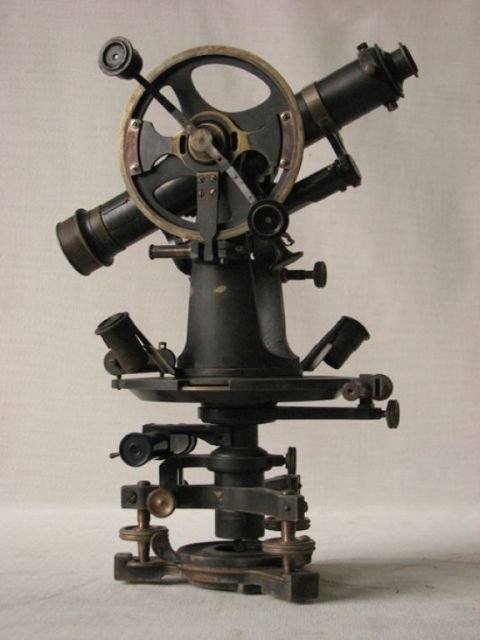TOTAL STATION THEODOLITE

-
Item owner - FNM
-
Category - FNM Collection
-
Inventory - 0406
-
Author - Filotecnica Salmoiraghi
-
Dimensions - height 37 cm; horizontal disc diameter 27 cm
-
Dating - 1900-1949
This theodolite basically consists of a base, an alidade with a telescope, and a horizontal and vertical graduated circles. The telescope has a horizontal axis, and rotates around a vertical axis perpendicular to the telescope’s optical axis. Above the telescope is a level for holding it perfectly horizontal. On the telescope is a graduated vertical sexagesimal circle for reading zenith angles. The telescope is supported by a forked alidade rotating around a vertical axis. The end of the alidade fork supports the pins of the horizontal axis bearing the telescope. A level incorporated in the alidade permits vertical positioning of its principal axis of rotation. The alidade’s axis is centred in relation to a horizontal graduated sexagesimal circle (360°) for reading azimuth angles. The graduated circle is engraved onto a disc fixed on the base supporting the instrument. The base is in turn fixed onto a supporting stand with a locknut.
A bubble level is anchored to the base to ensure proper positioning of the instrument. Three levelling screws allow the device to be levelled. Reading of the angles on the azimuth and zenith circles is facilitated by the presence of a micrometric screw and eyepieces. The theodolite is a geodetic and topographic instrument for high precision measurement of azimuth (direction) angles resting on horizontal planes, and zenith angles resting on vertical planes, necessary for the celerimensura method of planimetric and elevation surveying.
The theodolite is used in planimetric and elevation surveying for determining the routes of roads, railway lines, irrigation channels, and so on.
This theodolite was used by workers in Ferrovie Nord Milano’s technical offices until the 1970s. The instrument had to be rectified prior to use, checking that the alidade’s axis of rotation was vertical, the telescope’s optical axis of collimation was perpendicular to the axis of rotation, that this axis was horizontal, and that the instrument’s zenith had been rectified.
Azimuth measurements are taken on the horizontal circle, while zenith measurements are taken on the vertical one. To ensure the utmost precision, readings are repeated on different parts of the azimuth circle (adjustable with a screw), using the average of the readings calculated according to Bessel’s rule as the value. This means that to measure horizontal angles with the theodolite, you must first take a reading with the vertical circle on the left (first position of use) and then with the vertical circle on the right (second position of use). Two joint readings are thus obtained. To obtain the correct reading, without any errors of eccentricity, horizontality or orthogonality, it is necessary to calculate the average of the joint readings (Bessel's rule).
The theodolite also permits indirect measurement of the distance from a graduated rod (stadia mark) placed at a desired spot, provided the value of the theodolite’s diastimometric constant is known.
Reading of the position of the stadia mark using Bessel’s method, multiplied by the constant, determines the required distance.